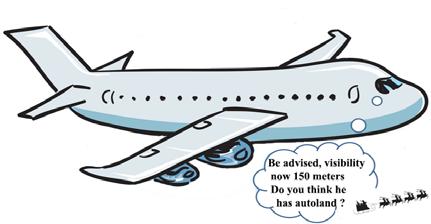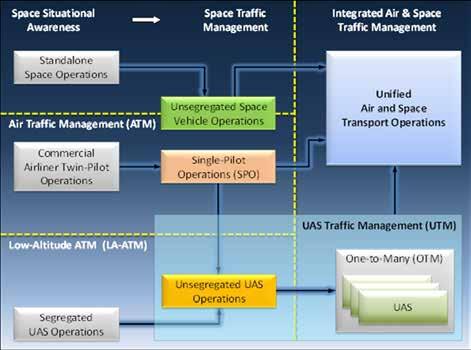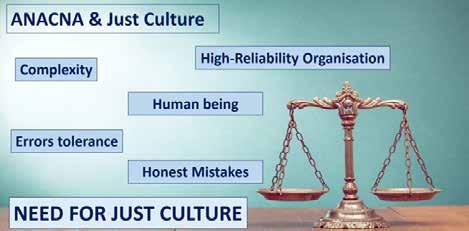
4 minute read
AVIATION ENGLISH BITE
a cura di Michael Ferrario
“Tower, How foggy is it?” ……. “Say Again”. It is not phrased properly for aviation purposes but it is a good question since fog is defined differently for aviation, meteorology and the general public. It is rather simple to remember that in aviation it is defined by visibility less than 1,000 m except when followed by “MI”, “BC”, “PR” or “VC” since each descriptor qualifier has a specific definition. Since fog and mist can seem to be the same thing, mist is when visibility is at least 1,000 m but not more than 5,000 m with no descriptor qualifiers. The FAA likes to use fractions so, fog is when visibility is less than 5/8 of a statue mile with “MI”, “BC”, “PR” or “VC” as descriptor qualifiers. While mist is greater than or equal to 5/8 of a statue mile to 6 statute miles (9.65 Km) with no descriptor qualifiers. So, how about the meteorological definition? You will be surprised to find that fog is just a cloud that touches the ground for most meteorological purposes but the WMO (World Metrology Organization) defines fog as “A suspension of very small, usually microscopic water droplets in the air, reducing visibility at the Earth’s surface.” and they go on to say, in various documents, “The term ‘’fog” is used when microscopic droplets reduce horizontal visibility at the Earth’s surface to less than one kilometer, while the term “mist” is used when the droplets do not reduce horizontal visibility to less than one kilometer”. When it comes to the general public, definitions become very diverse. It largely depends on what purpose the definition is being made for. Driving handbooks between countries and even between states in the U.S. offer different definitions. They seem to vary between 100 and 500 meters of visibility when describing fog. In practice, mist is considered synonymous with “light fog” as a way of describing it. Generally, by far the most common definition among many handbooks that I could find was that fog reduces visibility due to cloud touching the ground. The common thread between all these definitions is visibility, which can be defined simply as the distance at which a given known object can be seen and identified with the unaided eye but given that visibility can be observed at night and measured by instruments, we need to turn to a
Advertisement

more comprehensive definition. Doc 8896 states, “Visibility for aeronautical purposes is the greater of: a) the greatest distance at which a black object of suitable dimensions, situated near the ground, can be seen and recognized when observed against a bright background; and b) the greatest distance at which lights in the vicinity of 1 000 candelas can be seen and identified against an unlit background.” For aviation purposes, meteorological observers use prevailing visibility and observers and pilots can use vertical visibility but pilots also use slat-range visibility since they are aiming at a landing point and it is critical to seeing approach lights, runway end identifier lights and the runway environment in general during the final stages of an approach. Over the years, there has been debates in the ICAO and other organizations about how to best use vertical visibility and introduce slant-range visibility but the fact remains that the lower the visibility, the more challenging an approach becomes especially if a pilot is unprepared and lacks experience. In addition, this can apply for en-route situations. Looking down from a plane vertically through fog can make it seem as if the visibility is greater than it actually is as observed on the ground horizontally. The distance from the plane to the ground is less than distance the pilot needs to fly on an approach so what seemed like marginal VFR conditions vertically, will become IFR conditions while on approach. This also applies to mist and smoke. General aviation pilots flying under VFR conditions can find themselves over their head in low visibility that they did not expect. In Europe, this is a problem for GA pilots with an enroute instrument rating (not used in North America) as flight along the route can be IFR but the departure and arrival airport must be VMC in order to conduct the flight but as we know, weather conditions can change quickly and possibly leave them with no VFR alternative. A recent AOPA study found that 16% of GA weather-related accidents in the United States occurred in fog. General aviation pilots need a “nudge” now and then by repeating the current weather conditions, especially the visibility. If an airport in the area is VMC, let them know. It gives them another chance to let the information “sink in” so they can use their best judgement to make an informed decision.
P.S. If you establish contact with Santa, vector him to my house. I need to talk to him. Thanks.
Merry Christmas to all.


Corsi di INGLESE Climb level 4

Never stop learning
info@anacna.it

Via Camilla, 39/41 00181 Rome - Italye
Tel. +39.067842963 - Fax +39.0689012864
info@anacna.it
www.anacna.it
La rivista è aperta alla collaborazione di professionisti, studiosi ed esperti del controllo del traffico aereo e dell’assistenza al volo. Alcuni articoli, pubblicati come contributo indipendente di documentazione e critica, possono non esprimere il punto di vista dell’ANACNA.
Testi, foto e materiali in genere inviati alla redazione, anche se non pubblicati, non verranno restituiti.








